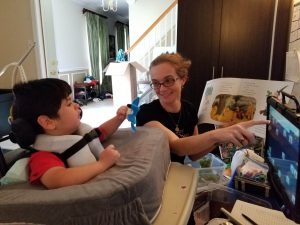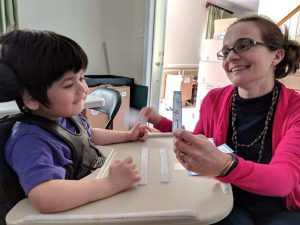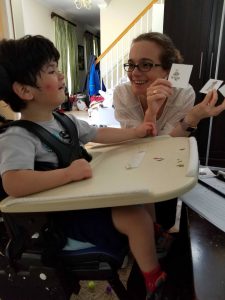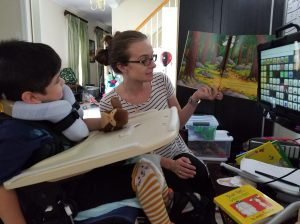 The other day when I arrived at Joey’s house he seemed taller and older to me. As I sat down to work he grinned and focused his eyes on his wall calendar, where there was a picture of balloons over yesterday’s date. Oh! It had been his birthday. Perhaps he looked taller and older because he was fully feeling the weight of being five. A big kid with big ideas, plans, and thoughts.
The other day when I arrived at Joey’s house he seemed taller and older to me. As I sat down to work he grinned and focused his eyes on his wall calendar, where there was a picture of balloons over yesterday’s date. Oh! It had been his birthday. Perhaps he looked taller and older because he was fully feeling the weight of being five. A big kid with big ideas, plans, and thoughts.
How is Joey already five? It seems crazy that this year has gone by so quickly. I love using Joey’s birthdays to remind me of what typical development looks like at this age. Sometimes when we work with kids like Joey we can get so caught up in what makes them different from others that we forget to see what makes them the same. [Read more…]

 I’m not sure what I’ll do if I have to read
I’m not sure what I’ll do if I have to read  “What comes next?” I asked Joey, holding up the 5 and the 14 number cards. We’d just put down four and were building a long number line. Joey looked me in the eyes, then promptly looked at the number 14. And then burst into a fit of giggles.
“What comes next?” I asked Joey, holding up the 5 and the 14 number cards. We’d just put down four and were building a long number line. Joey looked me in the eyes, then promptly looked at the number 14. And then burst into a fit of giggles.  On October fourth MaryAnn Shaw (one of Joey’s grandmothers and a special education professor) and I had the opportunity of presenting our research on Joey at the Pennsylvania Council for Exceptional Children’s conference. Other than this blog this was my first opportunity to share Joey with the world.
On October fourth MaryAnn Shaw (one of Joey’s grandmothers and a special education professor) and I had the opportunity of presenting our research on Joey at the Pennsylvania Council for Exceptional Children’s conference. Other than this blog this was my first opportunity to share Joey with the world. When I arrived at Joey’s house on Friday afternoon he was in a great mood. He was giggling and excited to read, and his personality shone throughout our whole session. We were reading The Gruffalo, which is about a mouse and an imaginary yet real scary monster. As we read about the scary Gruffalo with his terrible teeth in his terrible jaws, I tried to use it as an opportunity to model using body part words like teeth, tongue, knee, leg, back, etc.
When I arrived at Joey’s house on Friday afternoon he was in a great mood. He was giggling and excited to read, and his personality shone throughout our whole session. We were reading The Gruffalo, which is about a mouse and an imaginary yet real scary monster. As we read about the scary Gruffalo with his terrible teeth in his terrible jaws, I tried to use it as an opportunity to model using body part words like teeth, tongue, knee, leg, back, etc. 
